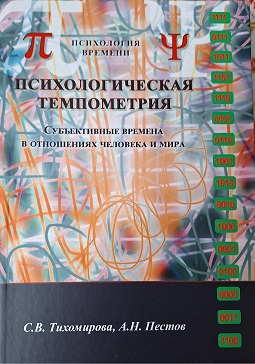tihomirovasv AT ipran.ru alexp.tempometry AT gmail.com

New Book.
PSYCHOLOGICAL TEMPOMETRY. SUBJECTIVE TIMES IN THE RELATIONS BETWEEN MAN AND THE WORLD
S. V. Tikhomirova1, A. N. Pestov
ISBN 978-5-00217-526-0
2025, Moscow. Editus. Second edition, adapted. 534 pages.
1. Institute of Psychology of the Russian Academy of Sciences, Moscow, Russia
Annotation
The content of the book demonstrates the development of scientific ideas of S. L. Rubinstein on orientation in times, with a focus on the concepts of vector, fluid dialectic of time definitions, tensions, the law of filled time intervals, the law of emotionally determined time assessment, the coordinate system of units of measurement tied to a natural starting point, which is the present moment, a priority setting for the future in the time experienced in the present moment.
In psychology, historically, the perception of time at one of the levels of psychic reflection - the level of sensations - is considered in detail. This book develops the fruitful distinctions about the levels of psychic reflection of the world and oneself in the world, made by L.B. Itelson.
Subjective times are considered with an emphasis on the formal level of psychic reflection using Boolean algebra. The finite, square matrix is a representation of a mental value, which is defined as a subjective assessment of the speed of approaching the desired.
Innovations have been introduced into known research methods. The distinctive novelty of the paradigm used is in emphasizing the outward direction, from the subject to the object, instead of perceiving time – its production. There is also an important substantial update of the experimental method used: in the experiments, not only intervals in the counting of subjectively equal durations are studied, but also pauses between interval counts. The Reciprocity of moving averages in intervals and pauses of subjective hours with decoding of the mental content of this reciprocity is established. In contrast to both descriptive and statistical approaches, the results of applying classical mathematical methods of processing the results are provided.
Metachronal waves in sequences of subjectively equal durations are revealed. A distinction is made between metastep and metachronal waves and their correct distinction is substantiated. The unevenness of the number series 0 1 2 3 4 5 6 7 8 9 10 11… in the Aristotelian concept of time is experimentally confirmed.
Laboratory time of psychological researches is separately identified. New auxiliary models of subjective times are proposed.
A collection of 30 articles “Subjective time: the philosophy, psychology, and neuroscience of temporality”, © 2014 Massachusetts Institute of Technology, edited by Valtteri Arstila and Dan Lloyd, is well known. It presents a broad scientific perspective on subjective time by foreign authors. Psychological tempometry can be considered as a worthy addition to these long-term studies, since the content of the book is distinguished not by a retelling with the adaptation of well-known Western methods and approaches to the topic, but by its own perspective on the topic of human aspirations from the side of his subjective times.
CONTENT
Preface
Introduction
Chapter 1. Distinguishing between different perspectives on subjective time
1.1. Subjective times
1.2. Theoretical premises of psychological tempometry
1.3. Two paradigms — perception and creation
1.4. The novelty of the tempometry paradigm — production of time
Chapter 2. Tempometry in the psyche
2.1. The category of time — two definitions of time
2.2. Distinguishing between times and instruments for measuring times
2.3. Concepts of physics and concepts of psychology
2.4. The emergence of the vector of subjective time
2.5. Temporal retrospective
2.6. Temporal perspective. Formalization and deepening of the concept
2.7. Four parameters of temporal perspective in its dynamic development. The changing tensor of temporal perspective. Stresses and stress transformations
2.8. Distinction for three qualitative certainties. h/k=1, h/k<1 and h/k>1
2.9. Peculiarity of the natural, proper coordinate system for subjective time and its difference from the Cartesian system
2.10. Introduction of an adequate term — tempometry
2.11. Time as extrapolation
2.12. Definition of subjective time
2.13. Stress as a property of subjective time
2.14. Scalar and vector theories
2.15. Collinearity of subjective times
Chapter 3. Space and geometry, time and tempometry. Metrics of spaces and tempometry of times
3.1. Geometry and tempometry. Geometrization of the world and subjective measurement of personality in life time. Metrics of subjective spaces and tempometry of subjective times
3.2. In geometry, the constant number π, in tempometry, the variable number Ψ
3.3. Derivation of the Psi number
3.4. Tempometry. Definition and demonstration
3.5. Metrics and tempo
3.6. Unevenness of scales in the psyche
3.7. Explanations for assigning a term to its content
3.8. The time component of dynamic images
3.9. The value of tempometry in sports, trade and in military operations on the battlefield. The boundaries of tempometry
3.10. Intensities in tempometry
3.11. The importance of tempometry for economics. Subjective times as a subject of social psychology
3.12. About the sense of tempo in sports
3.13. Tempometry and timing. Common features and differences
3.14. Digital values of time ranges
3.15. Distinguished time scales
3.16. Characteristic times
Chapter 4 Boolean algebra
4.1. Boolean Algebra, Social Psychology and Pushkin
4.2. Formalism and the Formal Level of Human Thinking
4.3. Operational Definitions for Filling and Interpreting Numbers in Matrix Cells
4.4. Limit State Table
4.5. Substantive Differences in Catalogues
Chapter 5 Initial Theoretical Framework and Delimitations
5.1. Conditional Quadrants of Consideration
5.2. Subjective Time under Conditions of Certainty and Uncertainty
5.3. Manipulation of Consciousness by Inducing Tempo
5.4. Other Frameworks for Considering the Subject
Chapter 6 Concepts of Psychological Tempometry. Deriving the Method from Theory
6.1. Importance of the Topic
6.2. Time as a Vector
6.3. Time Metrics
6.4. Coverage of the Subject in Defining Time
6.5. Definition of tempo in dictionaries
6.6. Unit interval
6.7. Deformations of the unit interval
6.8. Acceleration of subjective time as a concept
6.9. Regular equilateral triangle and regular equal-duration three-interval
6.10. Non-Euclidean time perspective
6.11. Usefulness of comparison with geometry
6.12. Conditional frequencies
6.13. Falling out of objective time
6.14. Temporal relations of man with the world
6.15. Conceptual model of subjective times of an individual
6.16. Four parameters of the vector of subjective time in matrix notation
6.17. Grounds laid for deriving a method of studying subjective times
6.18. On the usefulness of idealization
6.19. Tempometry as an activity
6.20. Experiences in time perception
6.21. The law of the filled time segment
6.22. Temporal subjective coordinates instead of one physical time
6.23. Derivation from the theory of the method of producing any equal intervals
6.24. The principle of arbitrariness of scale
6.25. Objective Time on the Palette of Subjective Times
6.26. Attention When Measuring Subjectively Equal Intervals
Chapter 7 Tempometry Methods
7.1. Innovations in Subjective Time Research
7.2. Novelty, Originality, and Priority of the Method Used
7.3. Tempometric Interval Scales of the Psyche
7.4. The Question of the Adequacy of Subjective Time Research Methods
7.5. Limitations of the Method
7.6. Toward the Realization of an Adequate Method for Producing Any Equal Intervals
7.7. About One Side Effect of the Method
7.8. About One Important Consequence
7.9. Efforts of Will
Chapter 8 Subjective Time in the Laboratory
Chapter 9 Matrix Representation in Psychology. Part 1
9.1. Mathematics in Psychology
9.2. Statistical Fallacies
9.3. Operating with Relationships of Time Quantities
9.4. The Future in the Present Moment
9.5. Selecting Parameters
Chapter 10 Matrix Representation in Psychology. Part 2
10.1. Selecting a Coordinate System for a Tensor
10.2. Peculiarity of the Natural Coordinate System of Subjective Time
10.3. Transition to Another Level of Explanation
10.4. Tempometric Perspective on the Example in the Work of R. Block and D. Zakay
10.5. Auxiliary Scans of the Components of the Subjective Time Vector
10.6. Formalization by Means of the Matrix
Representation of 4 Tensor Parameters: H, K, H°, K°
10.7. Limit State Table
10.8. Filling Boolean Matrices
10.9. Tempometrics of Subjective Time and the Metrics of Semantic Space in Their Unity in the H/K Notation
10.10. Towards the Prognostic Value of the Matrix Representation
10.11. Formalization of Semantic Space
(Meanings and Senses) and Subjective Time in Their Unity
10.12. Qualitative Certainties and the Measure of Coverage of Mental Phenomena
10.13. Fluid Dialectics of Temporal Definitions
10.14. At the Level of Theoretical Thinking
10.15. On Self-Application of the Laws of Thinking Established by Psychology
10.16. Hypothesis on the Conjugacy of Three Parameters
10.17. Saccades
10.18. Towards Visualization of Time
10.19. Subjectively — Speed, Objectively — Velocity
10.20. Procrastination
Chapter 11 Hypotheses for Confirmation and Independent Verification
Chapter 12 On Evidence Bases
Chapter 13 Qualities of Experiences and Frequencies of Subjective Times
13.1. The Set of Qualitative Certainties of Experiences
and Subjectively Estimated Speeds of Approaches of Future Moments
13.2. List of Basic Emotions and Feelings (Luk A. N., 1967)
13.3. Matrix Representation of Subjective Times
Chapter 14 Subjective Times in Musical Reflections
Chapter 15 Research Results
15.1. Two Tapping Test Methods
15.2. Reciprocity of Moving Averages in Intervals and Pauses When Measuring Subjectively Equal Duration.
Towards a Discussion on Subjective Time
15.3. Apparency of Equal Duration
15.4. Metachronal Waves
15.5. What's in the Depths of Subjective Time?
15.6. Fluctuations in Subjective Time
15.7. Negative Feedback in Subjective Time
Chapter 16 Results of a Group Experiment
16.1. The Theme of Emotional Loads in Their Influence on the Flow of Subjective Times
16.2. Gender Differences and Commonalities in Subjective Times
16.3. Diversity in the Choice of Units of Subjective Time
16.4. Relative Accuracy of Subjective Time
16.5. The Dialectics of Identity and Distinction in Subjective Times
16.6. Seismic Frequencies of Subjective Times
16.7. The Search for Stable Relationships in the Fluid Dialectics of Temporal Definitions
16.8. Convergence of Trends in Subjective Time
16.9. Divergence of Trends in Subjective Time
16.10. Underwater Test
16.11. Deformations of Interval Patterns against the Background of an Imperative Urge
16.12. Tempometric Features of Virtual Reality
Chapter 17 Experience of Foreign Studies of Subjective Time
1/F Fluctuation on Appearance in Tapping Rhythms
The Question of the Nature of Drift.
The Question of Nature Drift-Phenomena of Subjective Times
The Influence of Emotions on the Underestimation of Time Intervals
High Correlation of Pace and Tension
Strong Quasi-Need Acceleration of Subjective Time
Method for Measuring the Rate of Subjective Time
The Production of Subjective Times via Induction
Masashi Yamada and Takashi Tsumura
Smoking Abstinence Impairs Time Estimation Accuracy in
Cigarette Smokers Phenomenon of Katsumi Nagai
Phenomena of Guy Madison
Takashi Ogawa and
Junko Kusano
Phenomena of M. Yamada and T. Tsumura
Conditional Frequencies of Subjective Time
Japanese Schizophrenics and Nonschizophrenics
Fumiko Matsuda
Chapter 18 Models of Subjective Time
Chapter 19 Your Time
Appendix
1. On the 125th Anniversary of Subjective Time Research. The Psychology of Time: Looking Back and Forward, P. A.Hancock, University of Central Florida and Richard A. Block
2. The Effect of Cognitive Load on Duration Judgments. A Meta-Analytic Review.
Richard A. Block A., Peter A. Hancock B., Dan Zakay
3. The Experience of Time: Neural Mechanisms and the Interaction of Emotion, Cognition, and Embodiment. Marc Wittmann and Virginie van Wassenhove


